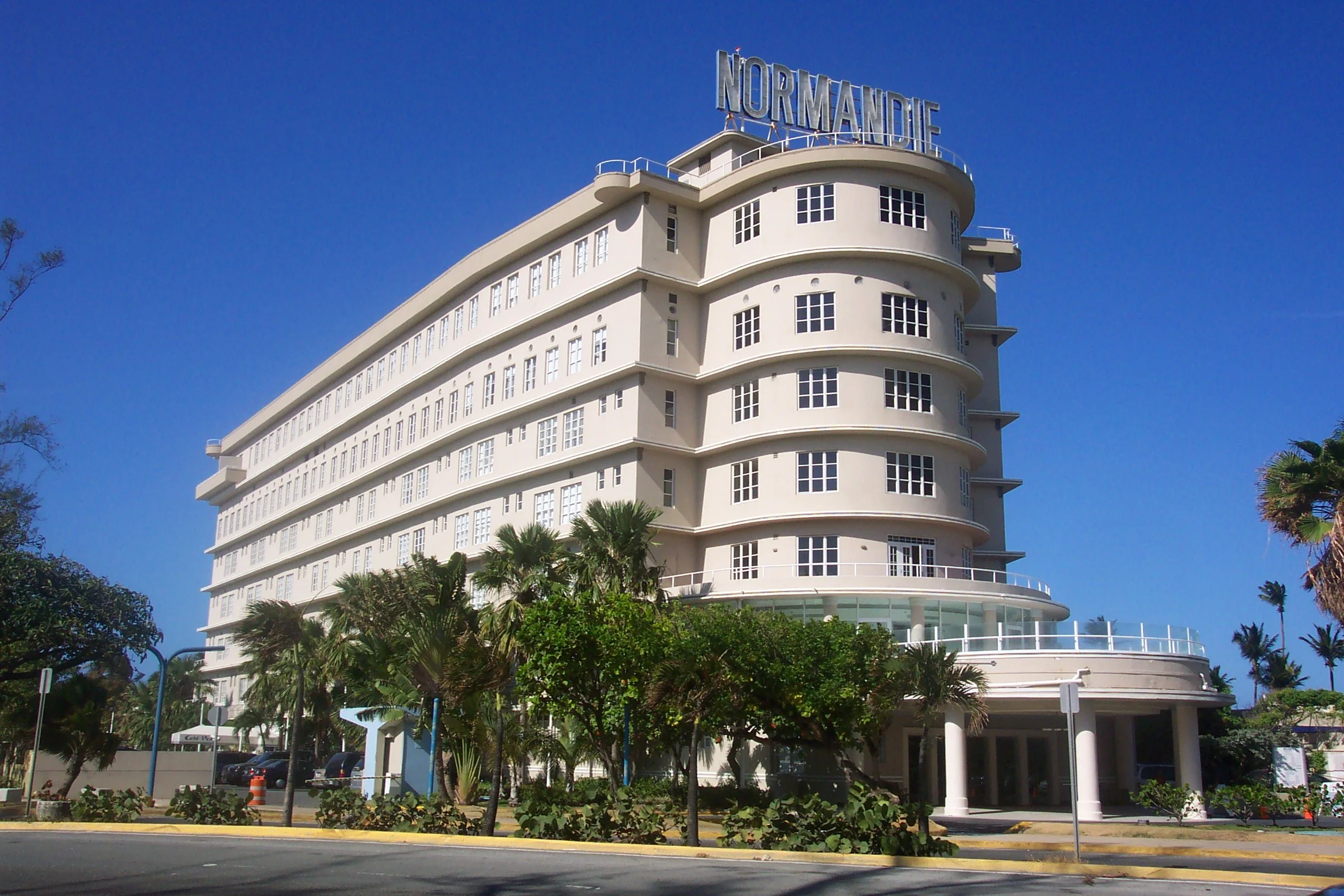Of Hotels and History: Luxury Beach Tourism in the New Gilded Age
By Safina Center Fellow Priya Parrotta
Normandie Hotel as seen from Munoz Rivera Avenue. Photo by Javier Rodriguez Galarza
In San Juan, Puerto Rico, between the tourist districts of Viejo San Juan and Condado, stands a crumbling hotel called the Normandie. Built in the 1940s, its art deco architecture and design was inspired by an ocean liner of the same name, which once traveled the seas and offered coveted luxury to the world’s elite. The hotel, which was built at the edge of Escambrón Beach (which is now home to many sea turtles), was once an immensely popular place of recreation and repose for wealthy travelers, politicians, celebrities and socialites. In the late 1990s, however, following significant damage from Hurricane Georges, the Normandie closed its doors. Over the subsequent decades, the structure—which was abandoned but not demolished—was transformed. The façade was worn down by sun and wind and rain, grasses started to sprout in what was once the driveway and the lobby, and at night, it was illuminated not by interior lighting, but rather by the moon.
As this process continued, the structure became ever more intriguing and beautiful to me. I grew up a mile or so away, and would often imagine what this building would become if it were to be completely rewilded. Perhaps trees would grow in its interior, becoming a habitat for birds. Perhaps, I would think whimsically, it could become a multispecies “community center” of sorts, in a neighborhood which was otherwise far too full of concrete. Perhaps it could, over time, crumble entirely, thereby making it possible for the coastal ecosystem of Escambrón to extend beyond its current boundaries.
I had long associated the original hotel with a bygone era—an era depicted in films like Titanic, when the world’s imperial and industrial elite traveled in luxury together, at sea and on the shore. A time of high empire and expanding industrial wealth, when the world’s most powerful talked easily and readily about carving up the world. A time of escalating hierarchy and violence towards the more-than-human world. A historical chapter which we are often told is behind us—mercifully closed, as a result of the labor movements, feminist struggles, and waves of decolonization which took place over the course of the twentieth century.
Recent events on tropical coastlines, however, have shown that this is far from the case. On the contrary: Across the Atlantic, Indian and Pacific Oceans, as well as the Caribbean and Mediterranean Seas, a new generation of luxury real estate developers are acquiring properties and securing permits to construct new condos and hotels for the world’s richest individuals. From Hawai`i to the Maldives to the Canary Islands, these developers (and the politicians who support them) are taking advantage of ecological and economic vulnerabilities—especially in the aftermath of natural disasters—to create new “opportunities” for exploitative and extractive forms of luxury and recreation. Meanwhile, commercial publications like Forbes and the Wall Street Journal help cement the illusion that the world’s beaches are for sale, frequently printing articles announcing new “destinations” for the world’s wealthy to visit and to acquire.
This is a global story—an emerging “geography,” as it were—of wealth and excess and entitlement which is causing tremendous suffering to both human and more-than-human beings around the world. And while this phenomenon bears so many of the hallmarks of this particular moment of globalization, international circuits of luxury beach tourism are by no means new. This has, in fact, happened before. In the late nineteenth and early twentieth centuries, coastal ecosystems around the world were commercialized, transformed into spaces for wealthy individuals (from the United States and Europe in particular) to travel, and stay, in great luxury. While these processes of commercialization certainly varied from place to place, they all involved major legal, ecological, and sociocultural overhauls which, then as now, were praised and/or glossed over by the leading newspapers of the time.
My third book project, titled The Paradise Industry: Law, Ecology, Media and the Making of the Tropical Island Beach, 1890-1930 is an in-depth exploration of the emergence of luxury beach tourism in the last decade of the nineteenth century, and the first decades of the twentieth. This year, the Safina Center is helping to support the first stage of this investigation: archival research on the commercialization of the beach zone of Waikīkī, Hawai`i. As I undertake this part of the project, it has become clear to me that the study of luxury beach tourism offers insights not only into the ways in which coastlines are devastated by powerful economic interests: It also generates valuable observations about how ecosystems and more-than-human beings in other settings are practically and discursively transformed from living beings with rights to peace and happiness, into products to be consumed by humans, in the name of recreation and “the good life.”
The Normandie, which to me has always symbolized the environmental hope that lies in material decay, was recently bought by a luxury developer, who has proposed “improvements” to the property which threaten the lives the sea turtles and other more-than-human beings who live at Escambrón. And these “improvements” are described in precisely the same way that parallel changes were promoted in Waikīkī over one hundred and thirty years ago. As it turns out, history not only repeats itself, but it often does so verbatim. Therefore, my hope with this book project is to elucidate certain aspects of this process of commercialization which, due to lack of transparency, are often hard to trace in the present. I hope this book can be a “guide” of sorts, which uses information and insights from a previous time of rampant inequality and violence to understand this new, global moment—when a multinational elite is, once again, acquiring the shorelines of the world, and remaking them for their own pleasure.

